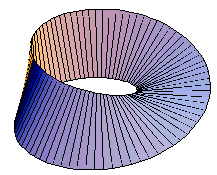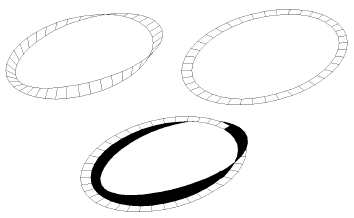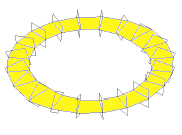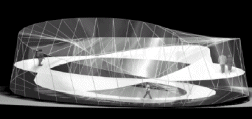The Möbius band is a fascinating object. You can make a simple model of it by joining the ends of a long, narrow strip of paper after giving one end a 180-degree twist. The result is a one-sided, one-edged surface in the form a single closed continuous curve with a twist.




Ever since its discovery in 1858 in a purely mathematical context, the Möbius band has played a role not only in mathematics but also in science, engineering, literature, art, music, dance, crafts, playthings, puzzles, and magic tricks.
Recently, Robert J. Krawczyk and Jolly Thulaseedas of the Illinois Institute of Technology in Chicago have been exploring the possibilities of Möbius forms as architectural structures.
“The Möbius band has several interesting properties that can be interpreted into architecture,” Krawczyk and Thulaseedas wrote in a paper presented last July at a conference in Spain on art and mathematics (see http://www.isama.org/conf/isama03/).
“The infiniteness and paradox of the Möbius can be demonstrated in terms of an enclosure in which one would walk around and feel the spatial twist without having to walk upside down,” Krawczyk and Thulaseedas stated. “The continuity, twist, and visual dynamism can be generated in terms of form and space where a Möbius band would split into a flat surface, on which one could walk, and a twisted Möbius surface that can be treated as a wall or ceiling or even floor at certain instances.”
Of course, it isn’t possible to stroll along a walkway in the shape of a Möbius band. The walkway’s twist would have you hanging upside down at some point along your path.
A Möbius band split into a twisted Möbius part (top left) and flat band (top right) can be recombined into a Möbius “floor” (bottom). |
One way to turn this form into a true walkway is to split the band into two parts—a flat band and a twisted Möbius component—then combine the parts so that they intersect.
“At certain intervals of travel, one encounters the Möbius floor that would rise to become the Möbius wall and eventually the Möbius ceiling or go back to the Möbius floor,” Krawczyk and Thulaseedas noted.
So, as you step along the flat band, you can still experience a Möbius structure—without suffering undue discomfort from trying to walk upside down. However, you can’t make a full circuit without bumping into an obstruction. Nonetheless, a large portion of the band is available for either a floor surface or even as a seating area.
Thickening a standard Möbius band so that its edge becomes as wide as the band’s side produces a three-dimensional object with a square cross section. The resulting form has two edges and two faces.
You can construct a model of this surface from a length of foam rubber with a square cross section. After rotating one end through 180 degrees, you simply fasten the ends together to form the twisted loop. If instead you rotate one end through 90 degrees before linking the ends, you wind up with a twisted loop with just one edge and one face!
An interesting architectural variant would be to construct a hollow Möbius enclosure, then hang a floor within it.
It’s possible to imagine Möbius structures as climbers or skating trails in a playground, as play elements in nursery schools, and even as museums, galleries, hotels, or walkways linking urban spaces. A Möbius museum, for instance, would be both an intriguing building and a piece of art.
“The geometry of the Möbius band has great potential as an architectural form—one that is difficult to investigate without the aid of digital technologies,” Krawczyk and Thulaseedas concluded. “It’s possible to develop a building that is a pure translation of a Möbius band, and it furthers a current trend in architectural forms being developed from mathematical concepts beyond mere inspiration.”
Frank Gehry, look out!






